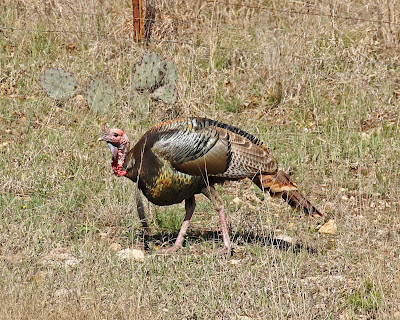Our second choice was the nearby Kerr Wildlife Management Area, which was actually open. Whoo-hoo!
This 6500 acre WMA was purchased in 1950, and is used primarily to conduct wildlife related studies and develop land management practices. They also host hunts, outdoor days, and training for wildlife managers.
Kerr WMA area is a breeding area for a couple of endangered species, the Golden-cheeked Warbler and the Black-capped Vireo. While they should be arriving any day we were apparently too early to find either.
We did see a Brown-headed Cowbird trap in operation.
Brown-headed Cowbirds are nest parasites, having evolved following Bison herds across the US. Rather than stopping to construct their own nests, they just drop their eggs off in some other species nest and leave it to those parents to raise their chick. The cowbird chick is larger and more aggressive than the chicks of the species that receive their eggs, so the host species chicks are often killed while the Cowbird survives.
One of these things is not like the other...
European Starling and Brown-headed Cowbird
The Brown-headed Cowbirds are particularly damaging to the nesting efforts of the two endangered species on the property, so cowbird traps are used to lower their populations. The traps lure cowbirds into the baited cages, but they can't figure out how to exit. While most of the captured birds are, umm, "disposed" of, a few are left to lure more in. The traps work very well and the reduction in Cowbirds has been a big boost to reproduction of the Golden-cheeked Warbler and Black-capped Vireo.
There is a nice driving tour through the property and we enjoyed a beautiful sunny day. The first bird we saw was an Eastern Bluebird.
Eastern Bluebird
A pair of Red-shouldered Hawks were calling overhead. Breeding season is definitely underway for some of these species.
Red-shouldered Hawk
There are a few water troughs on the property to support grazing cattle and wildlife. A group of sparrows was using one trough, and this Field Sparrow stuck around long enough for a picture.
Field Sparrow
This WMA is loaded with White-tailed Deer and Wild Turkeys. This pair of gobblers was really glowing in the sunlight.
Here is a close-up of one of the birds. The males grow a "beard" which is that growth of black fibers protruding from the chest. The longer the beard, the older the male. It is thought that the beard is attractive to females, though some female turkeys can also sport short beards.
Wild Turkey
On the way out I spotted a Barn Swallow on the wire. These birds show up at the beginning of March and are a sure sign of Spring!
Barn Swallow
We still plan to get over to the Heart of the Hills Hatchery, but this was a nice place to spend a morning.










Looks like spring is coming to your part of the country, if the birds are a sign anyway.
ReplyDeleteIs that your photo of the BHCO eggs? First time I saw a trap for them was some years ago on a Central Texas property I was hunting. If I remember correctly I think the landowner said he was paid by some state agency to trap and kill the birds.
ReplyDeleteNope. That is the one picture that I borrowed off of the internet as I've never seen a parasitized nest.
DeleteI've never heard of nest parasites - very interesting. Usually I am sympathetic to creatures being "disposed" of, but they should build their own darned nests.
ReplyDeleteIt is an interesting adaptation and one that didn't cause problems "way back when". But now that Cowbird populations have become static they can really interfere with other bird's success.
DeleteWhen we worked at Wichita Mountains NWR, we were involved in the cowbird elimination program. They would feed the dead cowbirds to the rapture that were being rehabilitated.
ReplyDelete